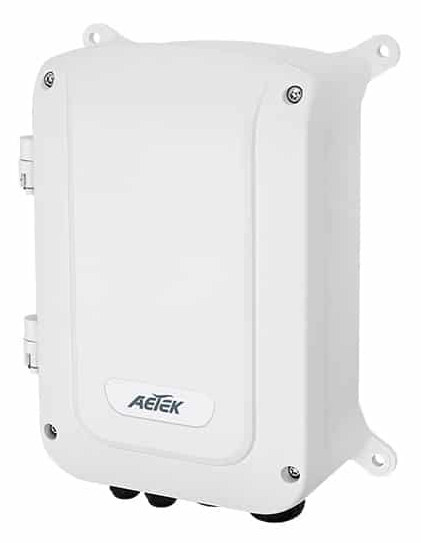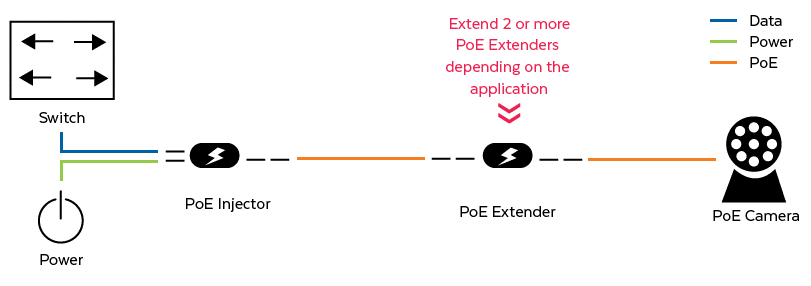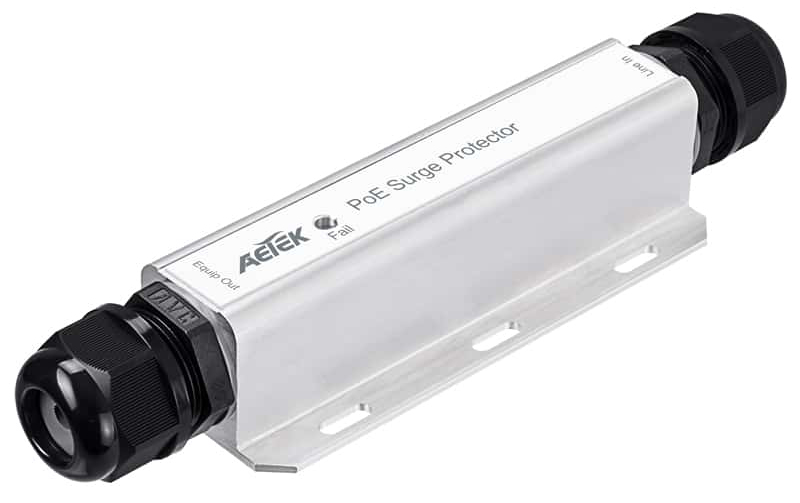Cities, hospital complexes, and educational campuses rely on the Internet of Things (IoT) to collect data at the network edge. These facilities can use this data for improved security, more efficient operations, and better end-user experiences. Cities use advanced technologies to monitor and manage transportation systems. Hospital complexes deploy way-finding devices to help patients, staff, and visitors locate needed resources. University campuses put intelligent surveillance systems in place to enhance student and faculty safety. Delivering end-to-end solutions requires outdoor devices that withstand extreme environmental conditions while maintaining everyday operations. It means finding technologies that function in hard-to-reach areas with limited power capabilities. Administrators need the flexibility to reconfigure network devices quickly with minimal disruption. Power over Ethernet (PoE) technologies can help build comprehensive solutions, including outdoor PoE deployments.
What is Power Over Ethernet (PoE)?
PoE technology allows power and data to be transmitted over a single Ethernet cable, eliminating the need for separate power sources. This technology relies on the Institute of Electronics and Electrical Engineering (IEEE) 802.3 standard series to ensure device interoperability. Today’s standards can send gigabits of data over Cat 5e, 6, 6a, and 8 Ethernet cables with a power budget ranging from 15 to 100 watts.
 The technology is especially useful in outdoor environments where power is unavailable. For example, surveillance cameras can be installed in parking lots or along walkways for enhanced coverage without worrying about power requirements. However, the reliable operation of PoE devices requires the careful consideration of several factors.
The technology is especially useful in outdoor environments where power is unavailable. For example, surveillance cameras can be installed in parking lots or along walkways for enhanced coverage without worrying about power requirements. However, the reliable operation of PoE devices requires the careful consideration of several factors.
Use Industrial PoE Switches
Industrial switches use metal frames that resist corrosion, vibrations, and shock. They can withstand chemical exposure and minimize wear and tear, prolonging their lifecycle. Depending on the switch, some products have built-in surge and overload protection. Industrial switches can operate in a wide range of temperatures, from -40°C to 75°C.
Industrial switches reduce the impact of traffic vibrations on operations, increasing the reliability of transportation systems. This temperature range means college campuses and hospital complexes from the Arctic tundra to the equatorial jungles can deploy PoE technology.
Deploy Weatherproof Enclosures
An industrial PoE switch should have a waterproof enclosure. As with any electrical device, PoE switches do not perform well in wet environments. PoE devices housed in waterproof enclosures minimize the impact of water on performance, leading to less downtime and fewer failures. 
Enclosures should have an IP67 rating to protect against environmental factors such as dust, particulates, and moisture. Their heavy-duty construction should also resist environmentally induced corrosion. PoE devices in weatherproof enclosures reduce replacement costs while ensuring reliable operations.
Have Backup Power Supplies
Storms, maintenance, and demand can cause power outages or fluctuations. A backup power source, such as an uninterruptible power supply (UPS), enables PoE-connected devices to continue operating even during a power failure. Properly configured backup power sources can begin providing power with minimal disruption, providing continuous operation for mission-critical applications.
Keeping lights on and traffic moving during a power outage reduces the chaos an outage can cause. Maintaining exterior lighting after dark keeps campuses and streets safe. Traffic systems can continue to receive traffic management data when controls aren’t working.
Consider PoE Extenders
PoE extenders or repeaters extend the standard connection distance between PoE devices and switches beyond 328 feet or 100 meters. Such devices regenerate signals to lengthen the distance without compromising performance. Extenders allow organizations to reach remote locations for data collection and monitoring.
 Hospital complexes can be difficult for patients and visitors to navigate. Digital exterior signage can help. This flexibility means users can quickly update navigational directions or messages to guide visitors. With extenders, way-finding signage can be placed where needed, not just where power is available.
Hospital complexes can be difficult for patients and visitors to navigate. Digital exterior signage can help. This flexibility means users can quickly update navigational directions or messages to guide visitors. With extenders, way-finding signage can be placed where needed, not just where power is available.
Install PoE Surge Protectors
Lightning, like water, can degrade the performance of PoE-enabled devices. An outdoor PoE surge protector can protect devices from voltage surges that damage equipment. Although industrial switches should have built-in surge protection, not all devices do. Surge protection allows excessive power to be safely redirected, preventing equipment damage.
Choose the Right Cable
PoE technology follows the IEEE 802.3 standards for devices that support up to 15 watts over two twisted pair cables. The IEEE 802.3bt standard establishes requirements for up to 60 watts over four twisted pair cables. The latest IEEE standard (802.3bt) can support up to 90 watts over four twisted pair Ethernet cables.
Choosing the right cable means evaluating connected devices’ power and data requirements. Reviewing the specifications of various cables, including categories 5e, 6, 6a, and 8, will ensure that the system meets demand.
Find the Best Location for Outdoor PoE
Although PoE technology can extend a network beyond traditional limits, it performs best when operating within specified distance, accessibility, and location limits.
Distance
Distance plays a role in determining the best location for PoE device installations. Voltage drops and electrical noise result if non-PoE network endpoints are too far from a power source. If a PoE switch is too far from network equipment, signals degrade, and users will experience reduced network performance. Although extenders can help maintain connectivity quality even in remote locations, equipment placement should ensure that network quality is maintained.
Accessibility
It’s important to place devices somewhere readily accessible to maintenance personnel and secured to prevent unauthorized access. Virtual access to devices should be similarly restricted and monitored to deter cyberattacks.
Location
Although outdoor PoE equipment is designed to withstand harsh environments, environmental qualities should still be considered when deployed. For example, direct sunlight exposure can raise a device’s temperature, damaging circuitry. Placing equipment in the known path of high winds and electrical storms increases device wear and tear.
Deploying PoE devices outside allows organizations to collect data for improved security. It delivers better end-user experiences and operational efficiencies. Considering the above mentioned factors can ensure companies receive the maximum benefit from their investment.
Versa Technology
Versa Technology, Inc. is an industry leader in Power over Ethernet (PoE) solutions and is committed to delivering outdoor PoE solutions for our customers.
 VX-GPF1626 24-Port GbE RJ45 + 2-Port GbE RJ45/SFP Web Smart+ GbE Managed PoE+ Switch
1 × $515.00
VX-GPF1626 24-Port GbE RJ45 + 2-Port GbE RJ45/SFP Web Smart+ GbE Managed PoE+ Switch
1 × $515.00  VX-GPU2610 L2+ 4-Port 802.3bt PoE + 4-Port 10/100/1000TX + 2-Port 100/1000X SFP Managed GbE UPOE Switch (240W, DMS)
1 × $489.00
VX-GPU2610 L2+ 4-Port 802.3bt PoE + 4-Port 10/100/1000TX + 2-Port 100/1000X SFP Managed GbE UPOE Switch (240W, DMS)
1 × $489.00 

 The technology is especially useful in outdoor environments where power is unavailable. For example, surveillance cameras can be installed in parking lots or along walkways for enhanced coverage without worrying about power requirements. However, the reliable operation of PoE devices requires the careful consideration of several factors.
The technology is especially useful in outdoor environments where power is unavailable. For example, surveillance cameras can be installed in parking lots or along walkways for enhanced coverage without worrying about power requirements. However, the reliable operation of PoE devices requires the careful consideration of several factors.
 Hospital complexes can be difficult for patients and visitors to navigate. Digital exterior signage can help. This flexibility means users can quickly update navigational directions or messages to guide visitors. With extenders, way-finding signage can be placed where needed, not just where power is available.
Hospital complexes can be difficult for patients and visitors to navigate. Digital exterior signage can help. This flexibility means users can quickly update navigational directions or messages to guide visitors. With extenders, way-finding signage can be placed where needed, not just where power is available.